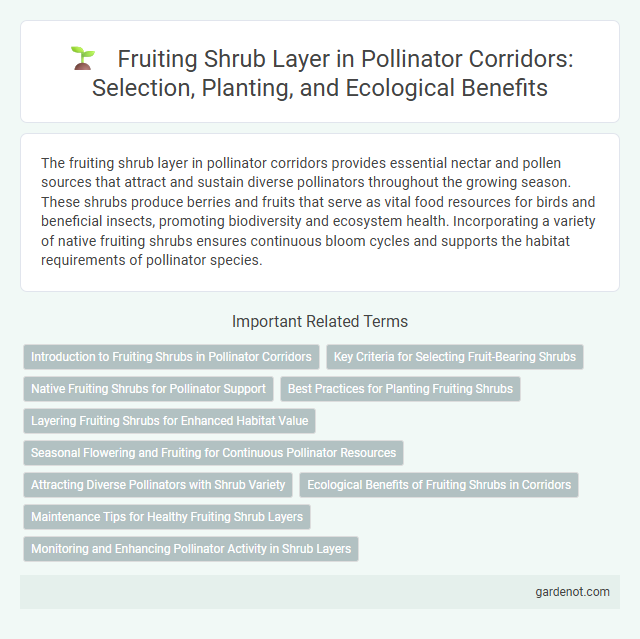The fruiting shrub layer in pollinator corridors provides essential nectar and pollen sources that attract and sustain diverse pollinators throughout the growing season. These shrubs produce berries and fruits that serve as vital food resources for birds and beneficial insects, promoting biodiversity and ecosystem health. Incorporating a variety of native fruiting shrubs ensures continuous bloom cycles and supports the habitat requirements of pollinator species.
Introduction to Fruiting Shrubs in Pollinator Corridors
Fruiting shrubs in pollinator corridors provide essential nectar and pollen resources that attract diverse pollinator species, including bees, butterflies, and birds. These shrubs produce berries and fruits that serve as vital food sources for wildlife, supporting biodiversity and ecosystem health. Incorporating native fruiting shrubs enhances habitat connectivity and promotes pollinator survival throughout seasonal changes.
Key Criteria for Selecting Fruit-Bearing Shrubs
Key criteria for selecting fruit-bearing shrubs in a pollinator corridor include native species that provide extended blooming periods and high nectar production to support diverse pollinator populations. Shrubs should produce nutrient-rich fruits known to attract birds and beneficial insects, enhancing ecological connectivity and wildlife foraging opportunities. Choosing plants with varying fruiting times ensures food availability throughout the growing season, promoting habitat resilience and pollinator health.
Native Fruiting Shrubs for Pollinator Support
Native fruiting shrubs such as serviceberry (Amelanchier spp.), elderberry (Sambucus spp.), and chokecherry (Prunus virginiana) provide essential pollen, nectar, and fruit resources for pollinators including bees, butterflies, and birds within pollinator corridors. These shrubs enhance biodiversity by supporting various pollinator species throughout different seasons while promoting habitat connectivity. Incorporating a diverse mix of native fruiting shrubs improves ecosystem resilience and boosts pollinator population health in restoration and conservation projects.
Best Practices for Planting Fruiting Shrubs
Plant fruiting shrubs in well-drained soil with full to partial sunlight to maximize fruit production and pollinator attraction. Choose native species like serviceberry (Amelanchier spp.) and elderberry (Sambucus spp.) that provide essential nectar and berries for bees, butterflies, and birds. Space shrubs at least 3-5 feet apart to ensure proper air circulation and facilitate pollinator movement within the corridor.
Layering Fruiting Shrubs for Enhanced Habitat Value
Layering fruiting shrubs in pollinator corridors creates a multi-tiered habitat that maximizes food resources and shelter for diverse pollinator species. Selecting native berry-producing plants such as elderberry, serviceberry, and chokeberry enhances year-round fruit availability, supporting birds and insects throughout the season. This stratified approach improves biodiversity, promotes ecosystem resilience, and strengthens pollinator populations by offering continuous nourishment.
Seasonal Flowering and Fruiting for Continuous Pollinator Resources
The fruiting shrub layer provides essential seasonal flowering and fruiting that ensures continuous pollinator resources throughout the year. This layer supports diverse pollinator species by offering staggered bloom periods and nutrient-rich fruits, enhancing ecosystem resilience and biodiversity. Effective management of the fruiting shrub layer promotes sustained habitat connectivity within pollinator corridors.
Attracting Diverse Pollinators with Shrub Variety
A diverse fruiting shrub layer enhances pollinator corridors by providing essential nectar and pollen resources that attract a wide range of pollinators such as bees, butterflies, and hummingbirds. Selecting native shrubs with staggered bloom times ensures continuous food supply, supporting pollinator health and biodiversity throughout the growing season. Incorporating species like elderberry, serviceberry, and blueberry creates habitat complexity that improves pollinator visitation and promotes ecosystem resilience.
Ecological Benefits of Fruiting Shrubs in Corridors
Fruiting shrubs in pollinator corridors provide essential resources by offering nectar, pollen, and berries that support diverse pollinator species and wildlife throughout the seasons. These shrubs enhance biodiversity by creating habitat complexity, improving food web stability, and facilitating pollinator movement across fragmented landscapes. Their presence boosts ecosystem resilience, contributing to more effective pollination services and increased fruit and seed production in surrounding plant communities.
Maintenance Tips for Healthy Fruiting Shrub Layers
Regular pruning of fruiting shrub layers promotes air circulation and sunlight penetration, essential for robust fruit development. Applying organic mulch conserves moisture, suppresses weeds, and enriches soil nutrients, supporting healthy growth. Monitoring for pests and diseases early enables targeted treatments, maintaining a thriving pollinator-friendly corridor.
Monitoring and Enhancing Pollinator Activity in Shrub Layers
Effective monitoring of pollinator activity in the fruiting shrub layer involves systematic surveys of insect visitation rates and identification of key pollinator species such as bees, butterflies, and hoverflies. Enhancing pollinator activity requires planting native, nectar-rich shrubs like elderberry (Sambucus nigra) and serviceberry (Amelanchier spp.) that provide continuous bloom periods and fruit resources, supporting both adult pollinators and their larvae. Maintaining habitat complexity and minimizing pesticide exposure in shrub layers further promote pollinator diversity and abundance, crucial for sustaining ecosystem pollination services.
Fruiting shrub layer Infographic

 gardenot.com
gardenot.com